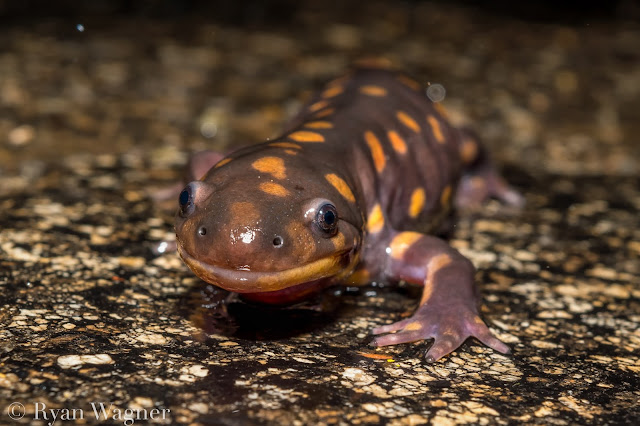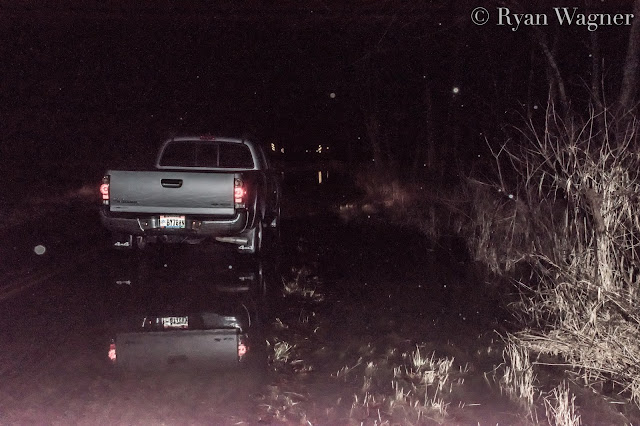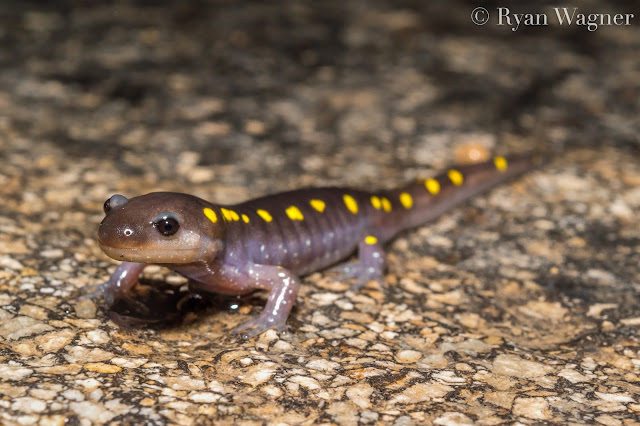I close my eyes and listen for their quiet rustling. Long, tube-like bodies create a distinct sliding sound, as they franticly zip through the leaf litter in a frenzied search for love. Nothing is quite like the sound of a garter snake navigating its way through the understory. It’s softer than the robin ruffling for insects in the substrate. It’s smoother than the scampering of a chipmunk dashing along a log. It persists as the gentle breeze tappers away into near silence. Silence, except for that deliberate sliding. Few sounds let me know instantly who is nearby, but just hearing doesn't always mean I’ll find my garter. They are clever, secretive, and quick. Patience, however, is often rewarded with the face of a skinny, striped reptile periscoping up at me through the tangles of vegetation.
 |
| Spot the garter snake. |
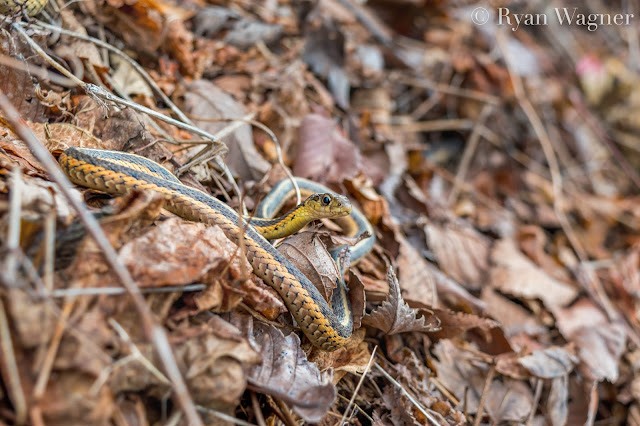 On special and unique occasions, however, wildlife isn't hard to find. Obvious examples include local backyard birds, squirrels, and deer. There is beauty in the abundance and resilience of these creatures, but even I stop looking at every gray squirrel or American robin that crosses my path. It’s a shame, but few are going to get inspired about nature and conservation from the animals they see every day. Backyard wildlife gets written off as a nuisance, closing the link to a world beyond our doorstep. It takes the unexpected to ignite curiosity. But there again, lies the crux of the issue. Folks don't know to be looking, and so they don't see what is right in front of them.
On special and unique occasions, however, wildlife isn't hard to find. Obvious examples include local backyard birds, squirrels, and deer. There is beauty in the abundance and resilience of these creatures, but even I stop looking at every gray squirrel or American robin that crosses my path. It’s a shame, but few are going to get inspired about nature and conservation from the animals they see every day. Backyard wildlife gets written off as a nuisance, closing the link to a world beyond our doorstep. It takes the unexpected to ignite curiosity. But there again, lies the crux of the issue. Folks don't know to be looking, and so they don't see what is right in front of them.
I have watched dumbfounded, as groups of hikers overlooked a massive female snapping turtle, never realizing that the oddly ridged stone they were hopping over wasn't a stone at all. I have seen others look right through the intense gaze of the local barred owl—never distinguishing her silhouette from her hemlock perch. When possible, I try to bridge the gap, bringing to light what others have missed. It is a delight to see joy spread across their faces as some new creature materializes before them. “I never would have noticed that on my own,” is the usual response. It breaks my heart to think of all the lost opportunities, because I know how powerful a connection to a wild creature can be. It only takes one introduction to the natural world to spark a passion that can change an entire world view.
 |
| The campus hibernaculum. |
Had I known about the campus hibernaculum before coming to Ohio University, I would have had no question in my mind what college was right for me. Tucked away on a vegetated hillside, smack dab in the center of campus, sits a refuge for dozens of scaly serpents. Eastern garter snakes (Thamnophis sirtalis) and northern water snakes (Nerodia sipedon) have taken up residence in the rock face. Every spring, they emerge to bask in the shrubbery along a frequently-used footpath. Hundreds of students and professors pass within inches of the snakes every day without ever realizing it. To calm the ophidiophobes among you, these are harmless species, growing to only a few feet in length.
The term hibernaculum refers to a location where reptiles overwinter. A well-drained cavity within the rocks provides a hiding place during the harshest months of the year. Here, the animals can slow down their metabolisms, reducing their energy use and need to feed. These hibernacula are often found on southward facing slopes, providing suitable basking spots in late winter and early spring. I have observed as many as ten snakes out basking in February, with snow still on the ground. Their tan and yellow stripes make for excellent camouflage against the forest floor. It's that tell-tail sliding that gives them away.
Garter snakes and water snakes exhibit a fascinating strategy of reproduction. Males begin to patrol the leaf litter as soon as the weather peaks into the 50s. Once a female emerges from the hibernaculum, males quickly swarm her, competing to be her mate. Like a scene straight out of Indiana Jones, these "mating balls" usually consists of one female and up to several dozen males. Once the males have locked onto the female's chemical cues, nothing can persuade them to leave her side. They entwine themselves with her body and use their chins to caress her head. The excitement may even frighten off the much larger female (up to three times the size of a male), in which case the frantic serpentine suitors will dart quickly after her.
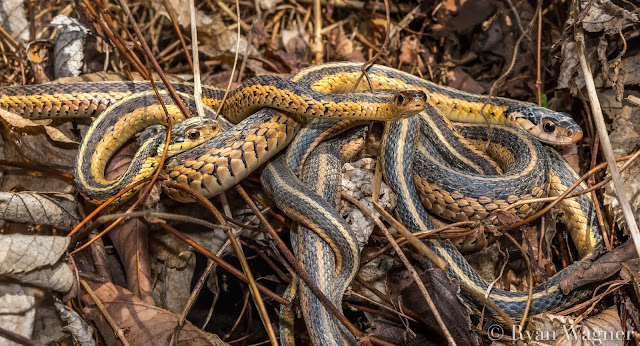 |
| A garter snake mating ball. Here two males (left) compete to mate with a large female (back right). |
When breeding finally takes place, the female will develop the eggs inside her body for one hundred days. Garter snakes are ovoviviparous, meaning they give birth to live young. Around twenty babies are born in late summer and fall, to which no maternal care is given. The neonate garters can fend for themselves from birth.




